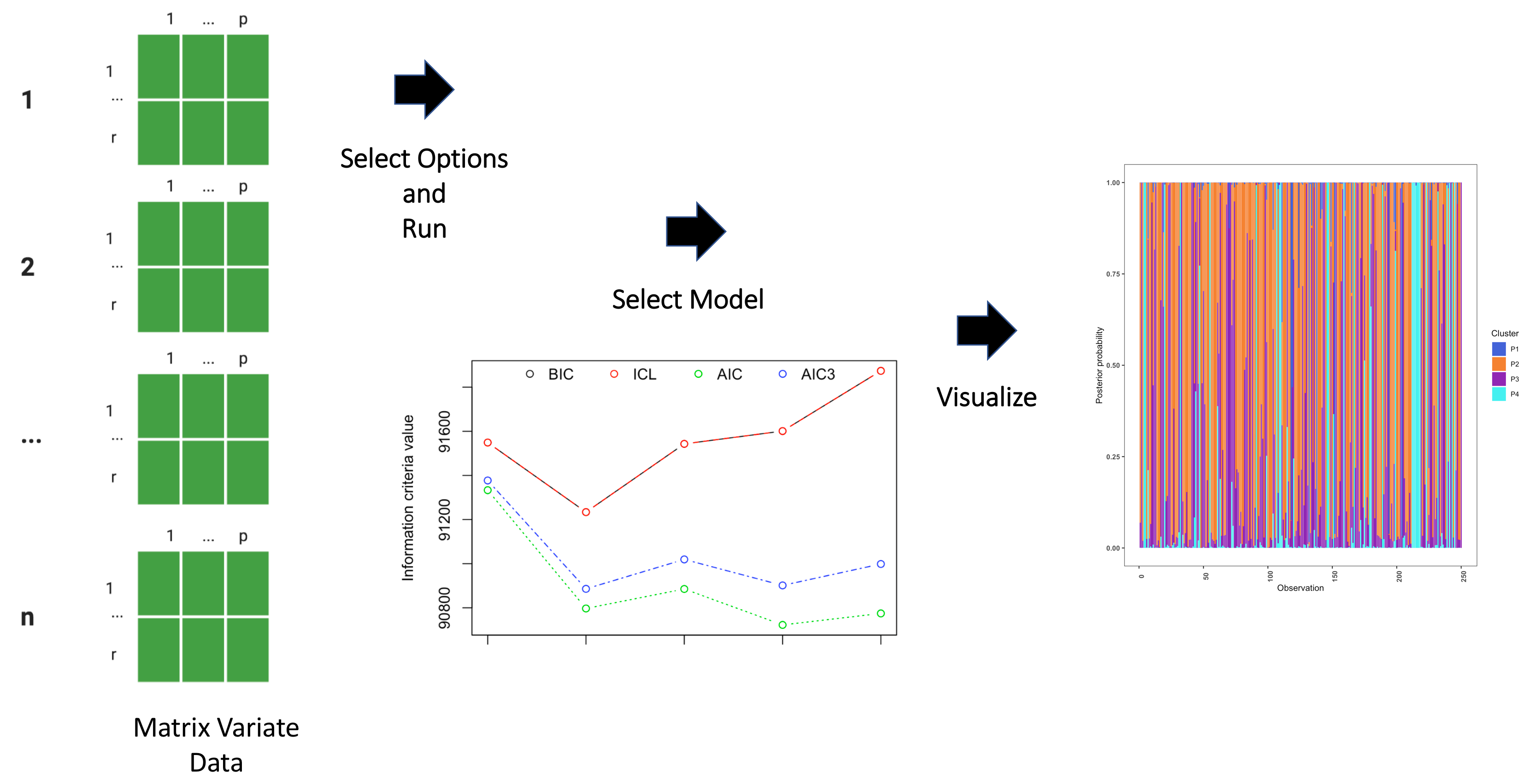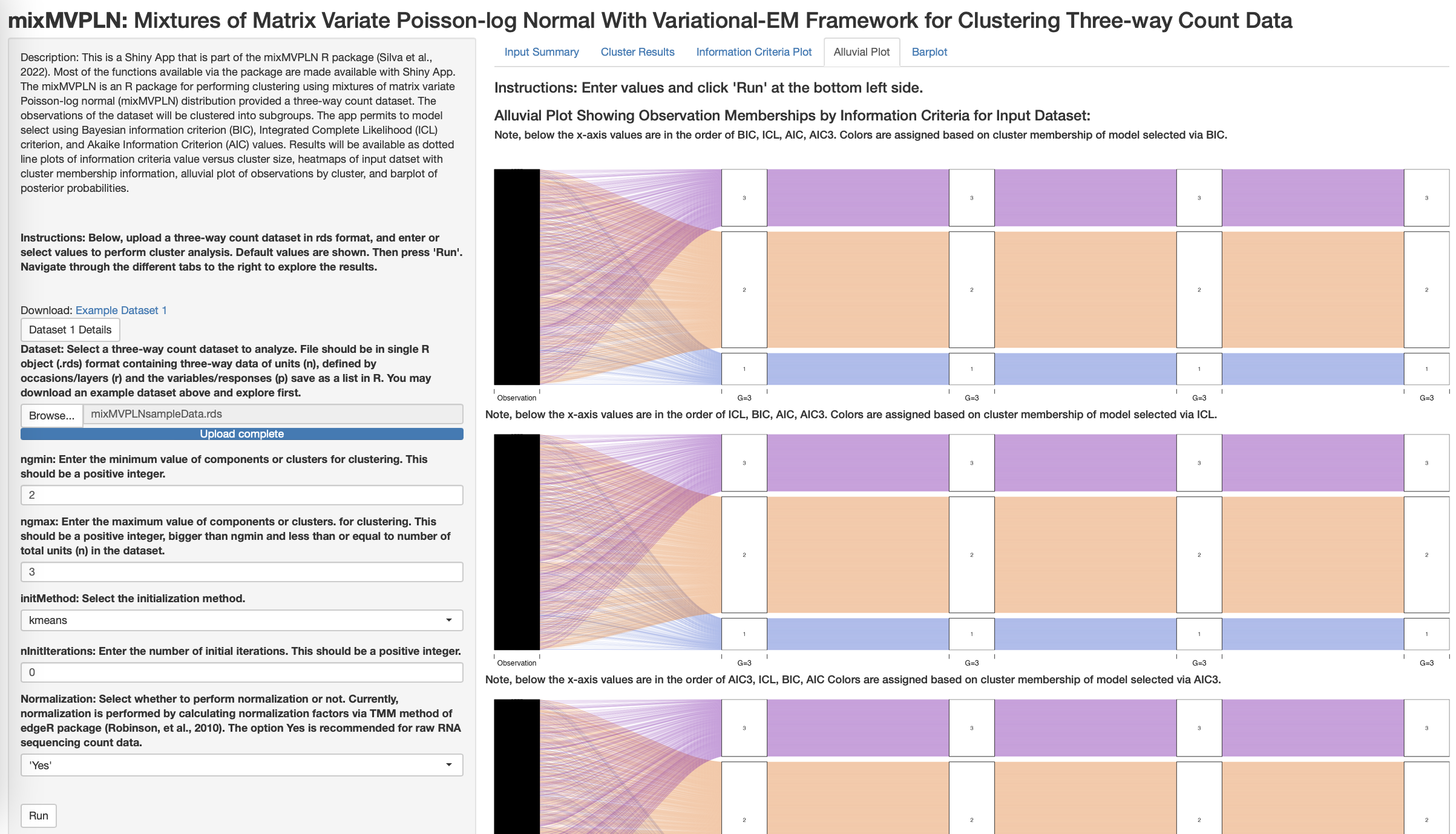Finite Mixtures of Matrix Variate Poisson-log Normal Model for Clustering Three-way Count Data
mixMVPLN is an R package for performing model-based clustering of
three-way count data using finite mixtures of matrix variate Poisson-log
normal (mixMVPLN) distributions (Silva et al.,
2023).
Three different frameworks are available for parameter estimation of the
mixMVPLN models:
-
method based on Markov chain Monte Carlo expectation-maximization algorithm (MCMC-EM),
-
method based on variational Gaussian approximations (VGAs), and
-
a hybrid approach that combines both the variational approximation-based approach and MCMC-EM-based approach.
Information criteria (AIC, BIC, AIC3 and ICL) are used for model selection. Also included are functions for simulating data from mixMVPLN model and visualization of clustered results.
To install the latest version of the package:
require("devtools")
devtools::install_github("anjalisilva/mixMVPLN", build_vignettes = TRUE)
library("mixMVPLN")To run the Shiny app:
mixMVPLN::runmixMVPLN()To list all functions available in the package:
ls("package:mixMVPLN")mixMVPLN contains 5 functions:
- mvplnDataGenerator for the purpose of generating simulation data via mixMVPLN
- mvplnMCMCclus for clustering of count data using mixMVPLN via method based on MCMC-EM with parallelization
- mvplnVGAclus for clustering of count data using mixMVPLN via method based on VGAs
- mvplnHybriDclus for clustering of count data using mixMVPLN via the hybrid approach that combines both the VGAs and MCMC-EM-based approach
- mvplnVisualize for visualization of clustering results as a barplot of probabilities
An overview of the package is illustrated below:

Two-way data is defined by units (the rows) and variables/responses (the columns). However, three-way data is defined by occasions/layers (r), in addition to the units (n) and the variables/responses (p). For two-way data, each observation is represented as a vector, while for three-way data, each observation can be regarded as a matrix. The matrix variate distributions offer a natural way for modeling three-way data. Extensions of matrix variate distributions in the context of mixture models have given rise to mixtures of matrix variate distributions,mwhich have been used to cluster three-way data
The multivariate Poisson-log normal (MPLN) distribution was proposed in 1989 (Aitchison and Ho, 1989). A multivariate Poisson-log normal mixture model for clustering of discrete/count data was proposed by Silva et al., 2019. Here, this work is extended. The MPLN distribution was extended in the three-way context to, first, propose the matrix variate Poisson-log normal (MVPLN) distribution for three-way count data. The MVPLN distributions can account for both the correlations between variables (p) and the correlations between occasions (r), as two different covariance matrices are used for the two modes. Next, the MVPLN distribution was extended in the mixture context and resulted the mixtures of matrix variate Poisson-log normal (mixMVPLN) distributions for clustering three-way count data as presented in Silva et al., 2023.
Three different frameworks for parameter estimation for the mixtures of MVPLN models are proposed: one based on Markov chain Monte Carlo expectation-maximization (MCMC-EM) algorithm, one based on variational Gaussian approximations (VGAs), and third based on a hybrid approach that combines VGAs with MCMC-EM.
The MCMC-EM algorithm via Stan is used for parameter estimation. This method is employed in the function mvplnMCMCclus. Coarse grain parallelization is employed, such that when a range of components/clusters (g = 1,…,G) are considered, each component/cluster is run on a different processor. This can be performed because each component/cluster size is independent from another. All components/clusters in the range to be tested have been parallelized to run on a seperate core using the parallel R package. The number of cores used for clustering is can be user-specified or calculated using parallel::detectCores() - 1. To check the convergence of MCMC chains, the potential scale reduction factor and the effective number of samples are used. The Heidelberger and Welch’s convergence diagnostic (Heidelberger and Welch, 1983) is used to check the convergence of the MCMC-EM algorithm.
MCMC-EM-based approach is computationally intensive; hence, we also provide a computationally efficient variational approximation framework for parameter estimation. This method is employed in the function mvplnVGAclus. Variational approximations (Wainwright et al., 2008) are approximate inference techniques in which a computationally convenient approximating density is used in place of a more complex but ‘true’ posterior density. The approximating density is obtained by minimizing the Kullback-Leibler (KL) divergence between the true and the approximating densities. A variational Gaussian approximations (VGAs) is used for parameter estimation, initially proposed for MPLN framework by Subedi and Browne, 2020. The VGAs approach is computationally efficient, however, it does not guarantee an exact posterior (Ghahramani and Beal, 1999).
A hybrid approach was proposed that combines the MCMC-EM-based approach and the VGAs. The hybrid approach comes with a substantial reduction in computational overhead compared to a traditional MCMC-EM but it can generate samples from the exact posterior distribution. This method is employed in the function mvplnHybriDclus. The method is as follows: first clustering based on VGAs is performed. Using the parameter estimates from VGAs results as the initial values for the parameters and using the classification results, next MCMC-EM is carried out to obtain the final estimates of the model parameters.
Four model selection criteria are offered, which include the Akaike information criterion (AIC; Akaike, 1973), the Bayesian information criterion (BIC; Schwarz, 1978), a variation of the AIC used by Bozdogan (1994) called AIC3, and the integrated completed likelihood (ICL; Biernacki et al., 2000).
Starting values (argument: initMethod) and the number of iterations for each chain (argument: nInitIterations) play an important role to the successful operation of this algorithm. There maybe issues with singularity, in which case altering starting values or initialization method may help.
Clustering results could be visualized as a barplot of probabilities.
The Shiny app employing hybrid approach (that combines the MCMC-EM-based approach and the VGAs) could be run and results could be visualized:
mixMVPLN::runmixMVPLN()
For tutorials, refer to the vignette:
browseVignettes("mixMVPLN")-
A Tour of mixMVPLN: Parameter Estimation via MCMC-EM
-
A Tour of mixMVPLN With Parameter Estimation via VGA
-
A Tour of mixMVPLN With Parameter Estimation via Hybrid Approach
citation("mixMVPLN")Silva, A., X. Qin, S. J. Rothstein, P. D. McNicholas, and S. Subedi (2023). Finite mixtures of matrix-variate Poisson-log normal distributions for three-way count data. Bioinformatics. 39(5).
A BibTeX entry for LaTeX users is
@Article{,
title = {Finite mixtures of matrix-variate Poisson-log normal distributions for three-way count data},
author = {A. Silva and X. Qin and S. J. Rothstein and P. D. McNicholas and S. Subedi},
journal = {Bioinformatics},
year = {2023},
volume = {39},
number = {5},
pages = {},
url = {https://academic.oup.com/bioinformatics/advance-article/doi/10.1093/bioinformatics/btad167/7108770?login=false},
}-
Aitchison, J. and C. H. Ho (1989). The multivariate Poisson-log normal distribution. Biometrika.
-
Schwarz, G. (1978). Estimating the dimension of a model. The Annals of Statistics 6.
- Anjali Silva (anjali@alumni.uoguelph.ca).
mixMVPLN welcomes issues, enhancement requests, and other
contributions. To submit an issue, use the GitHub
issues.
-
This work was initially started at University of Guelph, Ontario, Canada and was funded by Ontario Graduate Fellowship (Silva), Queen Elizabeth II Graduate Scholarship (Silva), Arthur Richmond Memorial Scholarship (Silva), and Discovery Grant from Natural Sciences and Engineering Research Council of Canada (Dang).
-
Later work of Silva was conducted at the Princess Margaret Cancer Centre - University Health Network, Ontario, Canada and was supported by CIHR Postdoctoral Fellowship and resources received for Postgraduate Affiliation Program of Vector Institute. Later work of Dang was conducted at Carleton University, Ontario Canada and was supported by Canada Research Chair Program.
-
We acknowledge Steven J. Rothstein (UGuelph), Paul D. McNicholas (McMasterU), Xiaoke Qin (CarletonU) and Marcelo Ponce (UToronto) for all their suggestions and contributions.



